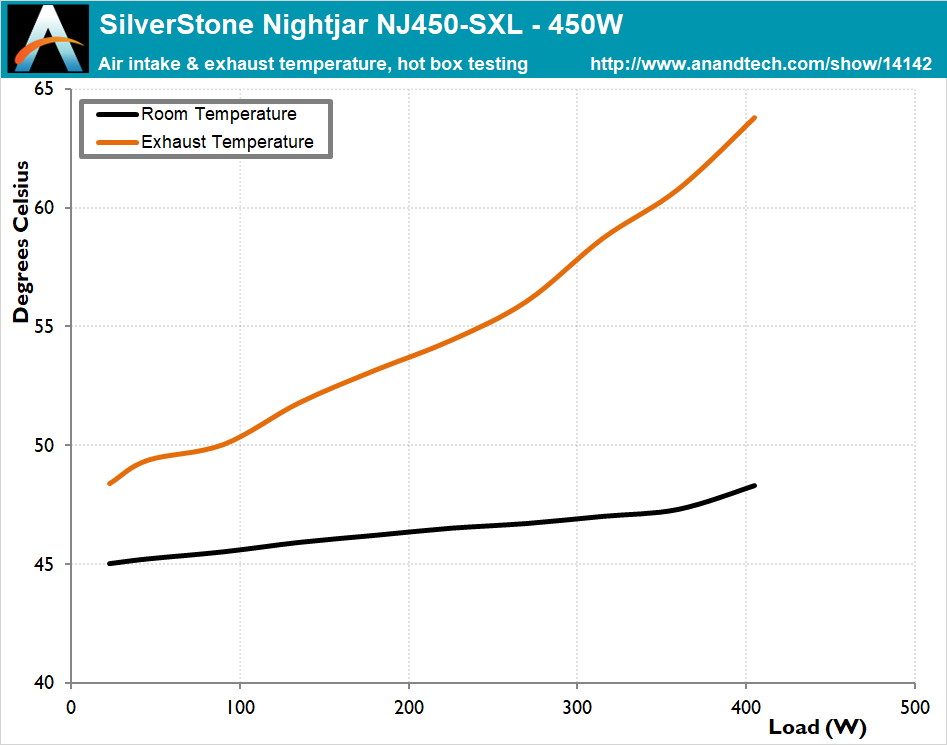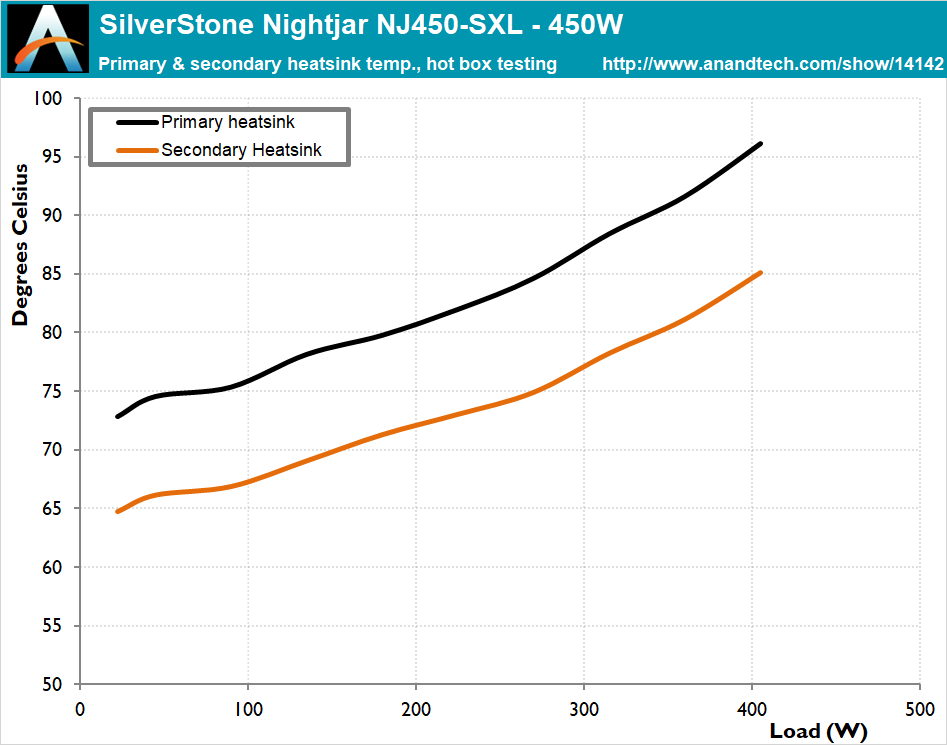The SilverStone Nightjar NJ450-SXL 450W SFX PSU Review: Passive Excellence
by E. Fylladitakis on April 4, 2019 8:00 AM EST- Posted in
- Cases/Cooling/PSUs
- PSUs
- SilverStone
- Passive Cooling
- SFX
- SFX-L
- Passive
Hot Test Results (~45°C Ambient Temperature)
Early SFX PSU designs displayed relatively poor power quality figures but we are constantly getting better and better performance figures from newer designs, indicating that manufacturers are now placing more resources on their design and development. The Nightjar NJ450-SXL feels eons ahead of the units that we reviewed merely a couple of years ago, displaying outstanding power quality figures that easily compare to those obtained from top-tier ATX units. However, we could not operate the unit stably inside our hotbox at 100% load, as the PSU would randomly shut down, therefore we were forced to limit our testing up to 90% load. SilverStone clearly states that this unit is rated for operation up to 40 °C and the high ambient temperature greatly impacts the unit’s ability to dissipate its thermal losses, so the behavior of its safety mechanism is both expected and welcome.
| Main Output | ||||||||
| Load (Watts) | 90,9 W | 227,11 W | 338,63 W | 400,78 W | ||||
| Load (Percent) | 20,2% | 50,47% | 75,25% | 89,06% | ||||
| Amperes | Volts | Amperes | Volts | Amperes | Volts | Amperes | Volts | |
| 3.3 V | 1,4 | 3,37 | 3,5 | 3,37 | 5,25 | 3,33 | 11,08 | 3,33 |
| 5 V | 1,31 | 5,05 | 3,28 | 5,02 | 4,93 | 4,99 | 10,38 | 4,97 |
| 12 V | 6,57 | 12,11 | 16,42 | 12,11 | 24,63 | 12,04 | 25,96 | 12,03 |
| Line | Regulation (20% to 100% load) |
Voltage Ripple (mV) | |||||
| 20% Load | 50% Load | 75% Load | 90% Load | CL1 12V |
CL2 3.3V + 5V |
||
| 3.3V | 1,2% | 16 | 12 | 14 | 18 | 20 | 18 |
| 5V | 1,6% | 18 | 16 | 16 | 20 | 20 | 22 |
| 12V | 0,6% | 24 | 14 | 16 | 26 | 24 | 20 |
SilverStone’s unit uniquely hits its best performance at 50% load, with the power quality figures worsening when the PSU is very lightly loaded. We recorded a maximum voltage ripple of 26 mV on the 12V line at 90% load, an impressive figure for any SFX PSU. Voltage regulation is very tight on the 12V line, at lower than 0.6% across the nominal output range. The secondary lines are not as tightly regulated, at 1.2% and 1.6% for the 3.3V and 5V lines respectively, yet these figures still are excellent by any measure.
The energy conversion efficiency of the SilverStone Nightjar NJ450-SXL takes a significant hit with the unit operating in our hotbox, a natural phenomenon considering the high internal temperatures of the unit under these operating conditions. The average efficiency reduction is 2%, equally distributed across the entire load range, suggesting that the efficiency drop is not due to the overstressing of a particular component but merely due to the high operating temperatures. Albeit the Nightjar NJ450-SXL is clearly not designed to withstand such operating conditions, it remains operable and it recovers safely from overloading/overheating conditions.














25 Comments
View All Comments
Death666Angel - Monday, April 8, 2019 - link
I have 2 monitors with interal power supplies that are caged by metal sheets and the only gap in that sheet are the power and display plugs. I can hear the whining noise very easily, once I move my head behind the monitor. In front of it, there is no noticeable noise (likely blocked by the display itself). But it is not that cut and dry.nagi603 - Monday, April 8, 2019 - link
Yeah, metal sheets are not good noise dampeners :DIcehawk - Thursday, April 4, 2019 - link
I have had one of these running 24-7 in my rig for about 7 years with no problems, have a higher wattage passive in my new box too. My PCs are very quiet with no PSU fans or mech HDDs. These are built to a high quality compared to a typical $50 PSU and is reflected in their cost.R3MF - Thursday, April 4, 2019 - link
i have a ~13 year old Nightjar 300W still running fine.Samus - Friday, April 5, 2019 - link
I've used a Seasonic X400 passive cooled PSU in my media PC (Silverstone ML03 case) for around 10 years. No problems at all. It started as an Intel i5-650 with a GeForce 430, then graduated to an AMD A10-9700, and is currently an i3-8100 still with the same GeForce 430 I used a decade ago because to me it makes a virtually perfect HTPC video card.The entire PC has always been passively cooled. A voltmod and BIOS flash to the EVGA GeForce 430 reduced its clock speed to 500MHz (1000MHz shader) and basically cut its TDP in half, allowing for a passive heatsink to be more than effective, and the CPU has used a NoFan CR-80eh cooler for most of this units life. The old Lynnfield CPU I used a Scythe Kozuti that needed modification to fit the motherboard\case by bending some heatpipes and the attached fins, which I broke removing it from the CPU when I upgraded (technically downgraded lol) the platform to an AMD A10. The A10 was a slower CPU but had much better thermal efficiency than the old i5, and the GPU was pretty good. The i3-8100 is absolutely perfect and the system has never run cooler. Total wall power draw during 1080p 24.976hz h264 video playback is 66 watts measured from a kill-a-watt and there are TWO SSD's and a 10TB HDD inside the case!
It's worth mentioning this is also my torrent PC so it is 24/7 albeit pretty low constant load.
All that said, the PSU and case have been through multiple generations of components.
DanNeely - Thursday, April 4, 2019 - link
As a general question, I'm wondering when we might start to see PSUs ship with only sata connector strings and a sata-molex adapter or two in the package similar to how the berg connector originally for the 3.5" floppy drive has been mostly done over the last decade.b1ghen - Thursday, April 4, 2019 - link
Probably never since the SATA connector isn't rated for enough current (1.5A I believe) and might melt if you hook up anything power hungry to the Molex in such a setup. A Molex can supply up to 13A i think. So a single Molex can supply 8x the current as a single SATA.daniel78R - Thursday, April 4, 2019 - link
I think S-ATA is 1.5A per pin, and if I remember well there are 3 pins for 3.3V, 3 for 5V and 3 for 12V, that would be 9.9w + 15w + 36w = 60.9V. Molex is 11A i think for 12V, 132w. However, the cables themselves are more important, also the specs of the PSU itself. I've seen PSUs with much less Amps per Molex or SATA rails. Also, I think some of my modular PSUs have the same port for SATA and Molex use on the PSU side.While Molex and Floppy connector might be needed for powering fans and such, I doubt you will ever use for powering anything close to 130w. AFAIK the most power hungry HDDs were about 10-12w
29a - Thursday, April 4, 2019 - link
Hopefully never. I'd much rather have them and not need them than need them and not have them.flyingpants265 - Tuesday, April 9, 2019 - link
What if they made them modular and let you select your own cables?